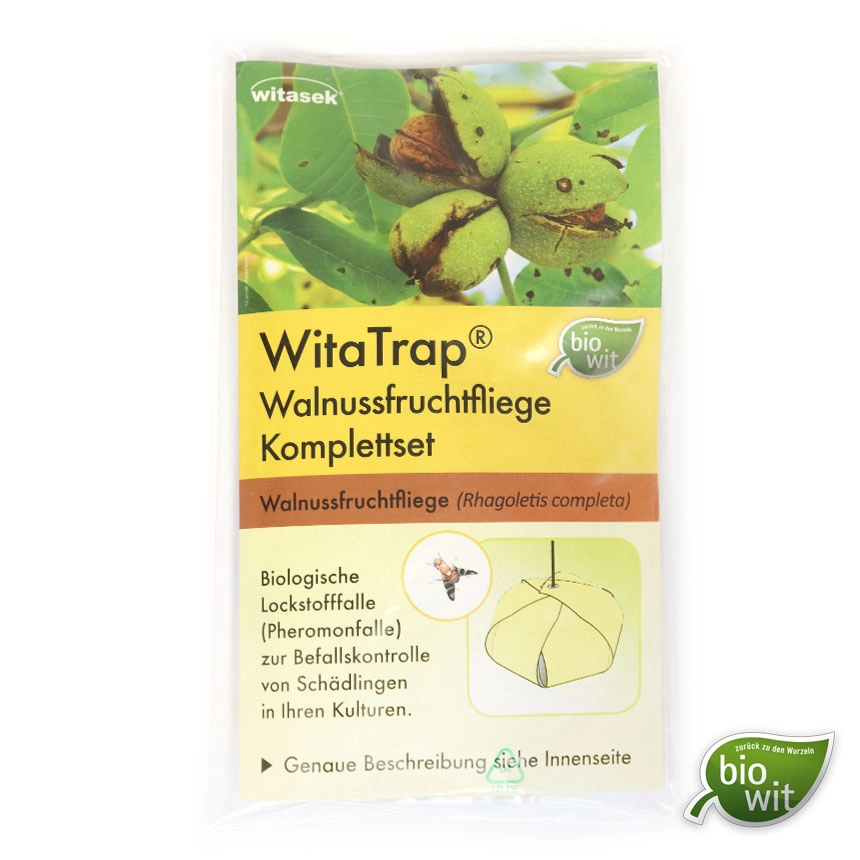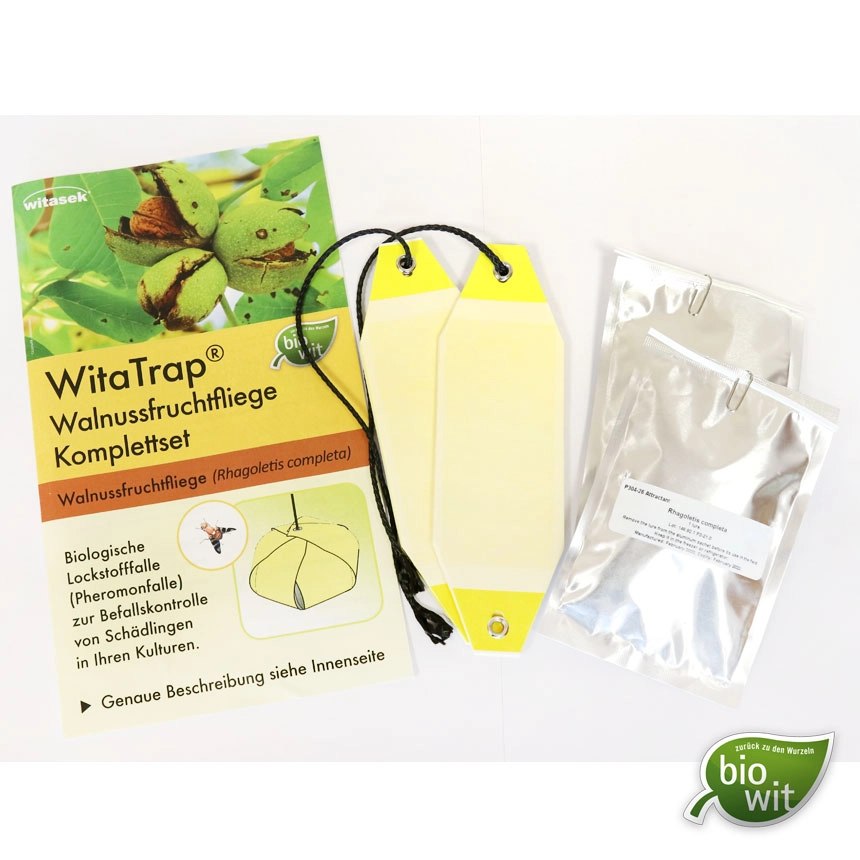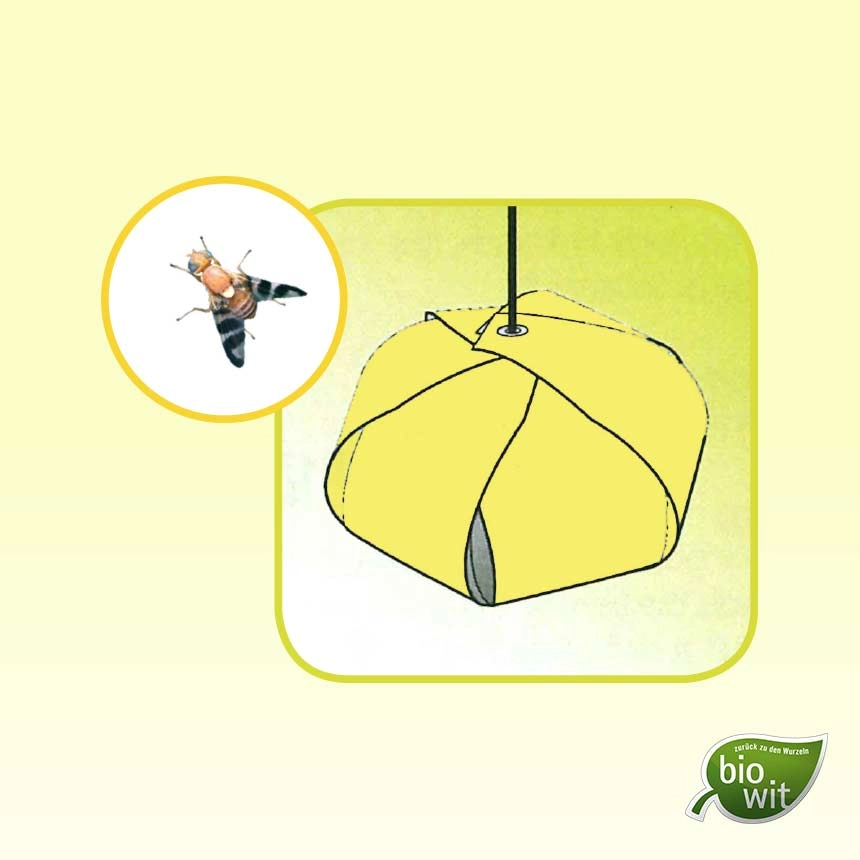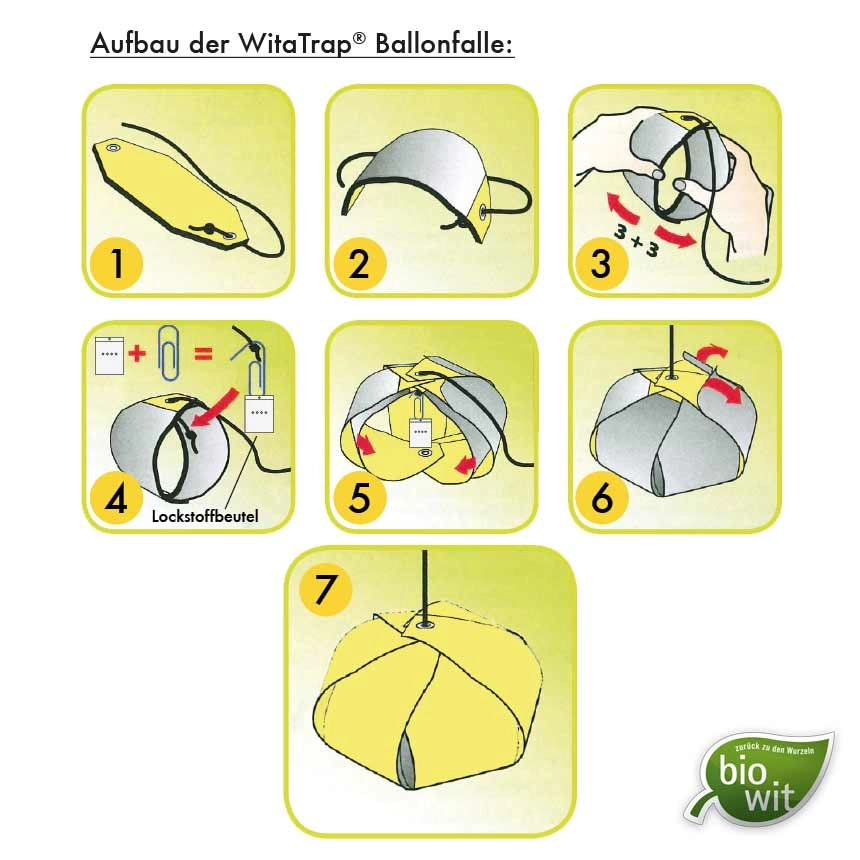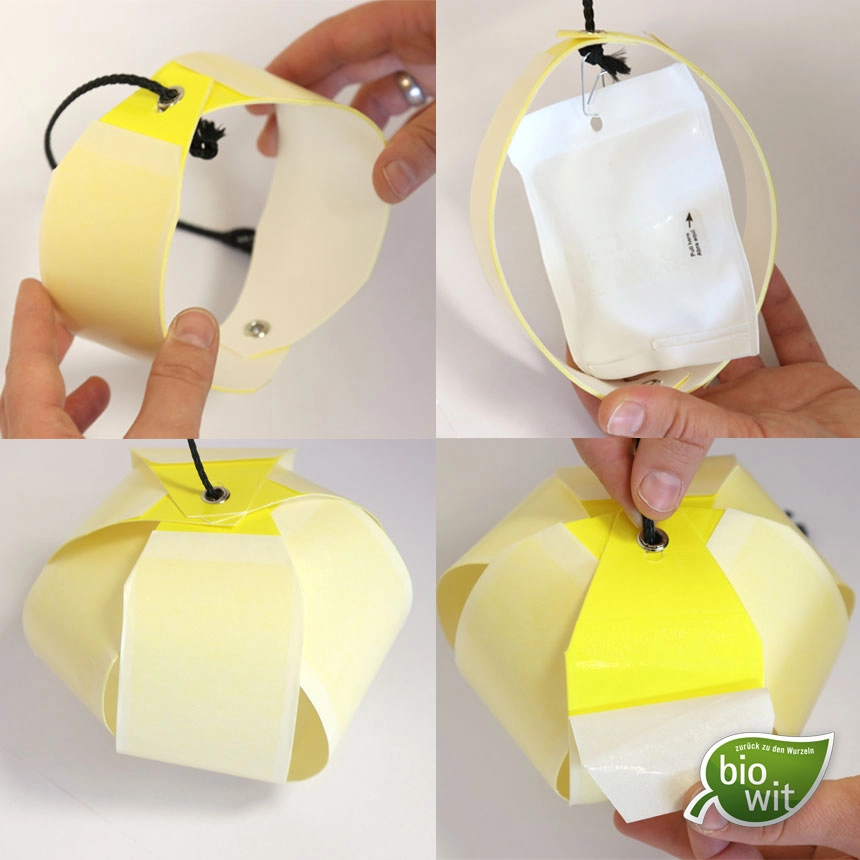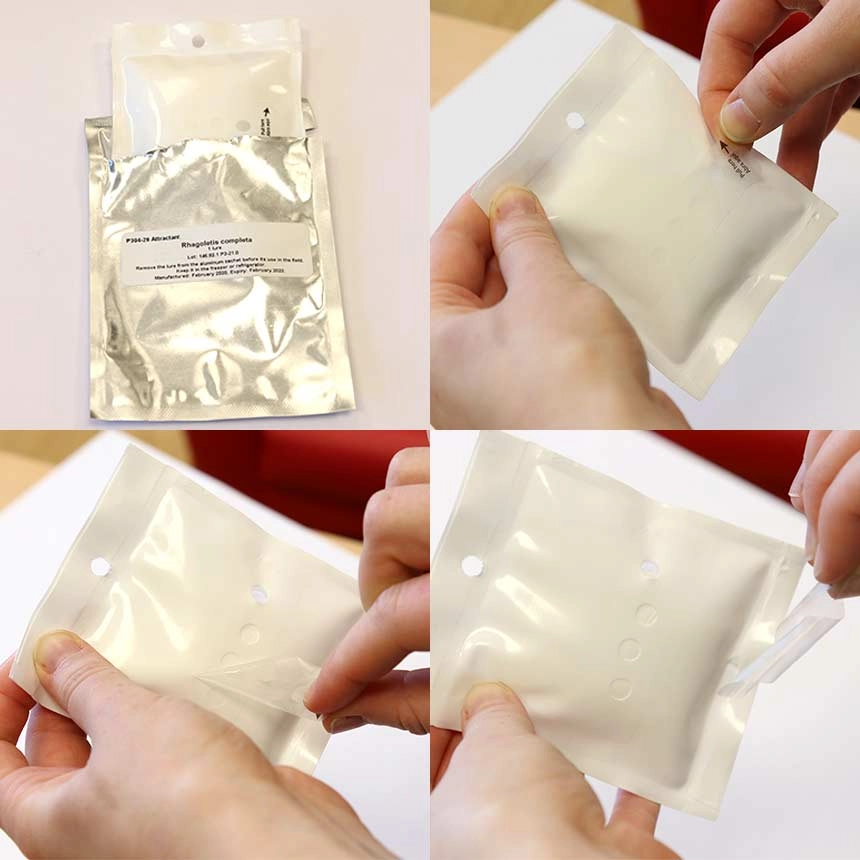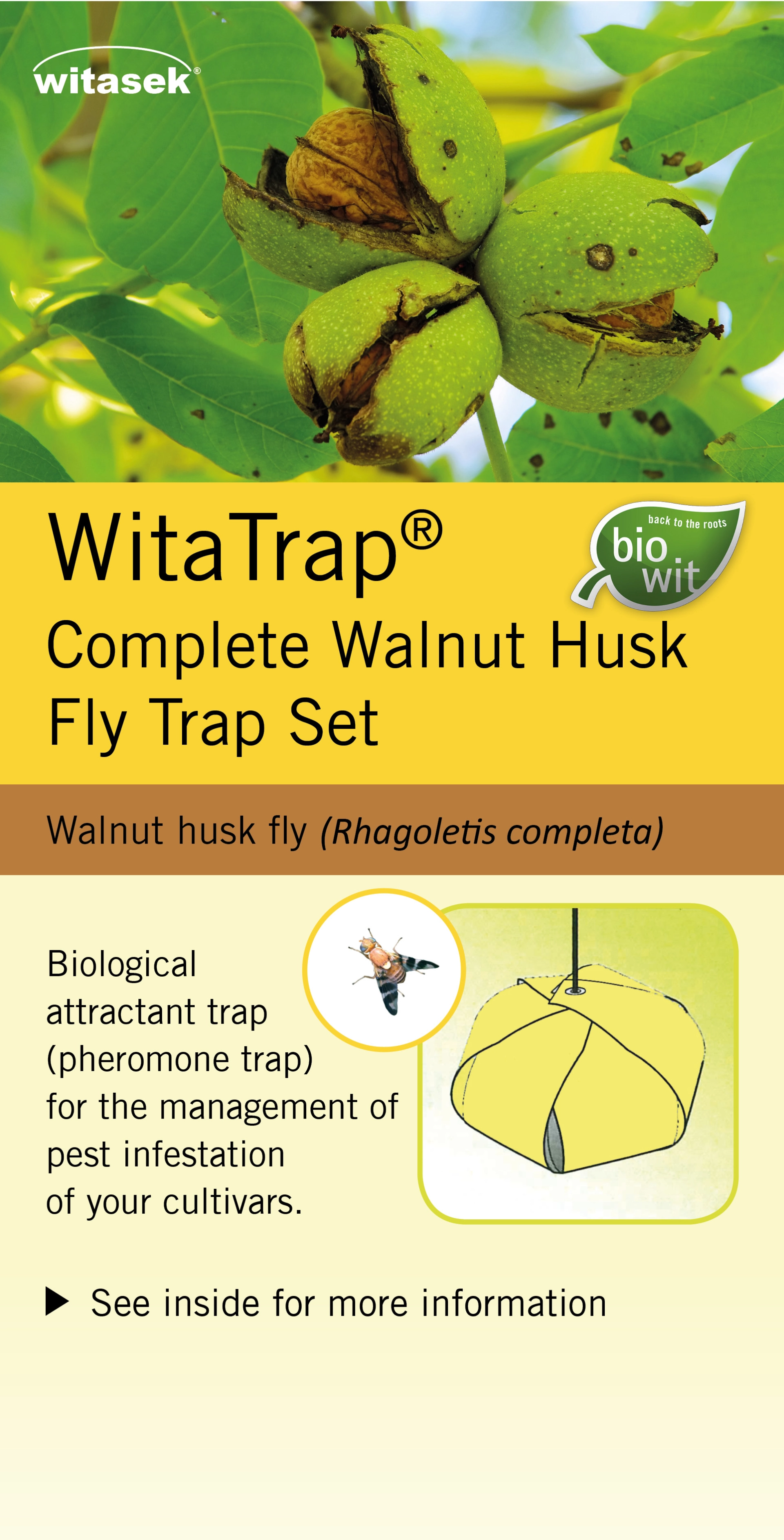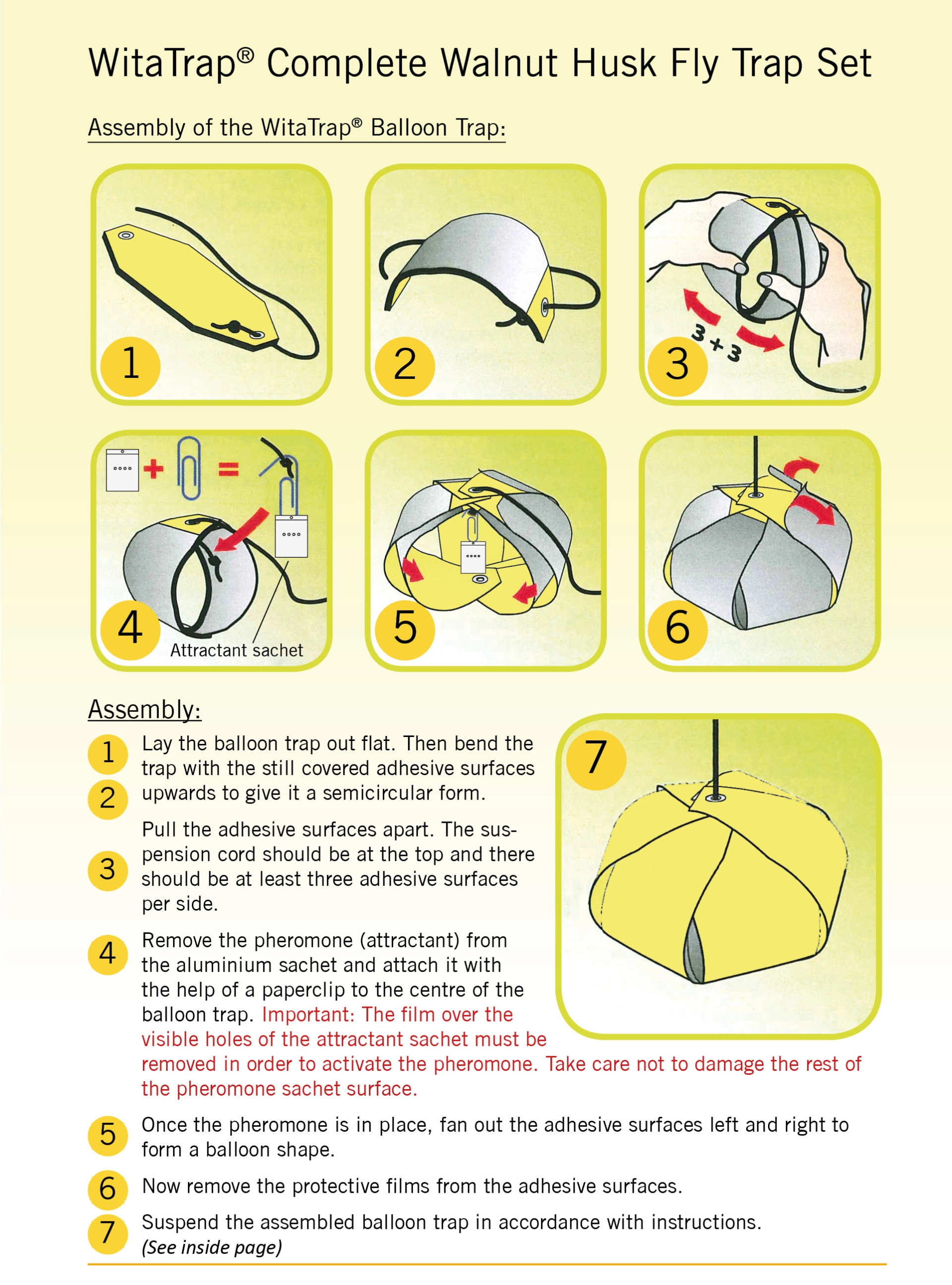WitaTrap® Complete Walnut Husk Fly Trap Set
| Quantity | Price per Set |
|---|---|
| To 9 |
€29.29
|
| From 10 |
€25.36
|
Available, delivery time: 7-10 Tage

Average rating of 0 out of 5 stars
Description
Product information "WitaTrap® Complete Walnut Husk Fly Trap Set"
WitaTrap® Complete Walnut Husk Fly Trap Set
Biological attractant trap (pheromone trap) for the management of pest infestation of your cultivars.
One trap set consisting of:
- 2 trap bodies (WitaTrap® Balloon Trap),
- 2 pheromone sachets (attractant) (separately packaged!),
- suspension cord for mounting
- detailed instructions for use.
Biology of the pest:
Pest: walnut husk fly
Scientific name: Rhagoletis completa
Infests: walnuts (Juglans spp.), black walnuts (Juglans nigra)
The walnut husk fly (Rhagoletis completa) is an introduced species and, as a beneficiary of climate change, is increasingly becoming a serious pest that damages mainly cultivated walnuts but also the wild-growing black walnut.
Main symptoms of infestation: As a result of the feeding behaviour of the larvae, not only nutshells can become blackened and unattractive, but nuts can also be damaged. There is no damage to trees or leaves. There can be differences in the susceptibility of varieties to infestation by the pest. Early ripening varieties are more attractive to the pest than late ripening varieties.
Biology:
Similar to the European cherry fruit fly, the walnut husk fly only produces one generation per year, whereby insects overwinter (diapause phase) in pupa form in the soil.
Egg deposition: in late July, 12 - 15 eggs are laid under the skin of the fruit husks
Development phase: 5 days
Main flight phase: early July to late September
Optimal conditions: long, warm summers
Use:
Assemble the trap and hang it from a branch or post.
In order to avoid attracting the pest insects directly to the nut tree to be protected, hang the trap from another tree (that is not a nut tree) in the vicinity. If this is not possible, the trap can also be hung from a suitably high post driven into the ground.
Hang the trap at eye level between the main wind direction and the tree. Make sure the trap entrances are not blocked by twigs and leaves.
Each trap should be checked at regular intervals of 2 - 3 days. Each time a trap is checked, the insects sticking to the adhesive surfaces should be removed using a suitable tool (e.g. twig or wooden scraper) to ensure that the full glue surface is revealed.
If surfaces become very soiled, replace the trap or spray with a liquid glue, such as Soveurode special glue.
Replace the attractant and the trap if necessary roughly every 4 - 8 weeks.
*Traps should be put in place before the flight phase of the adults.
Use of the Completawit attractant bag: The foil over the visible holes of the attractant bag must be removed to activate the attractant bag. The emaining bag must not be damaged and is hung into the attractant trap via the round punched hole on the top.
For more information on the insect pest and application, see the enclosed product description.
Reviews 0
0 of 0 reviews
Average rating of 0 out of 5 stars
Login
Accessories
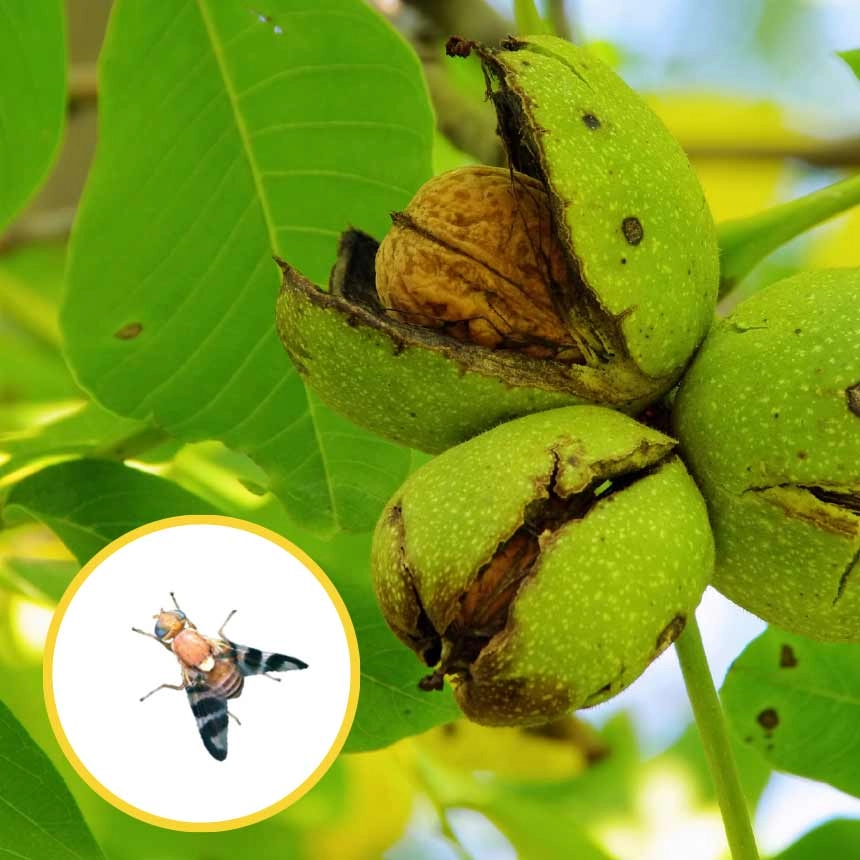
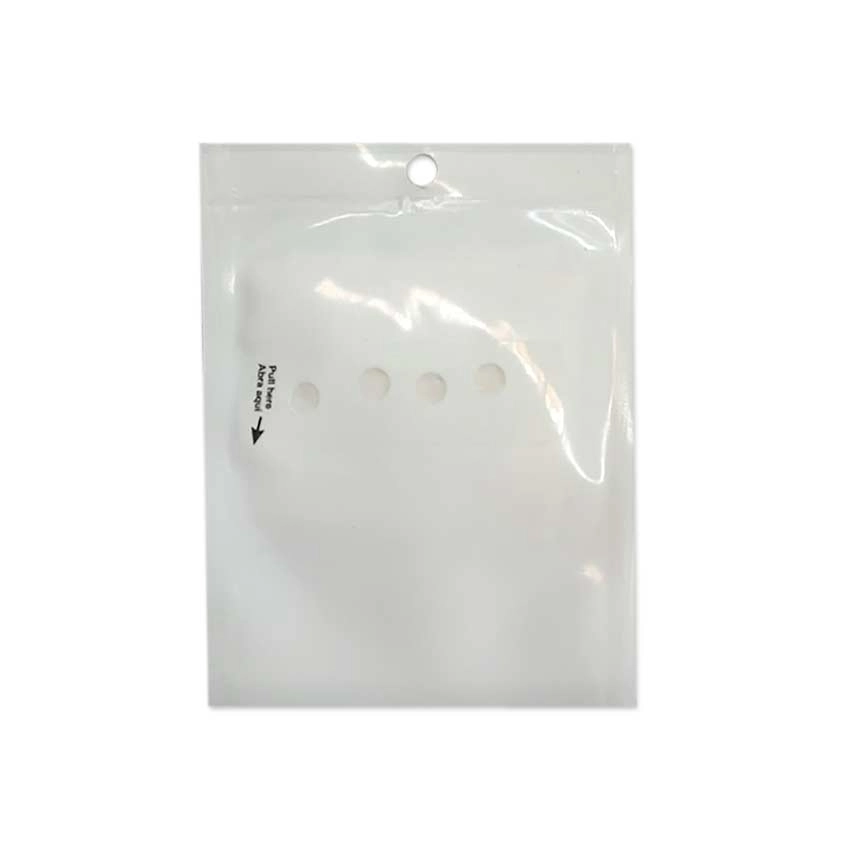
Average rating of 0 out of 5 stars
Pheromone to attract the walnut husk fly (Rhagoletis completa) shipping unit: pack of 5 pieces against insects in fruit growing: walnut husk fly (Rhagoletis completa) pheromone type: standard dispenser effective: approx. 6 to 8 weeks**depending on weather conditions Read product informations before use! This is available below as a download: "Handling of Pheromones Witasek"Storage of pheromones: Store product in tightly closed original packaging (usually aluminium packaging), in a well-ventilated place, in a cool and dry place. Keep away from heat and ignition sources. Recommended storage: at minus temperatures e.g. in the freezer.Suitable traps can be found under "Accessories Articles" below.
Similar products
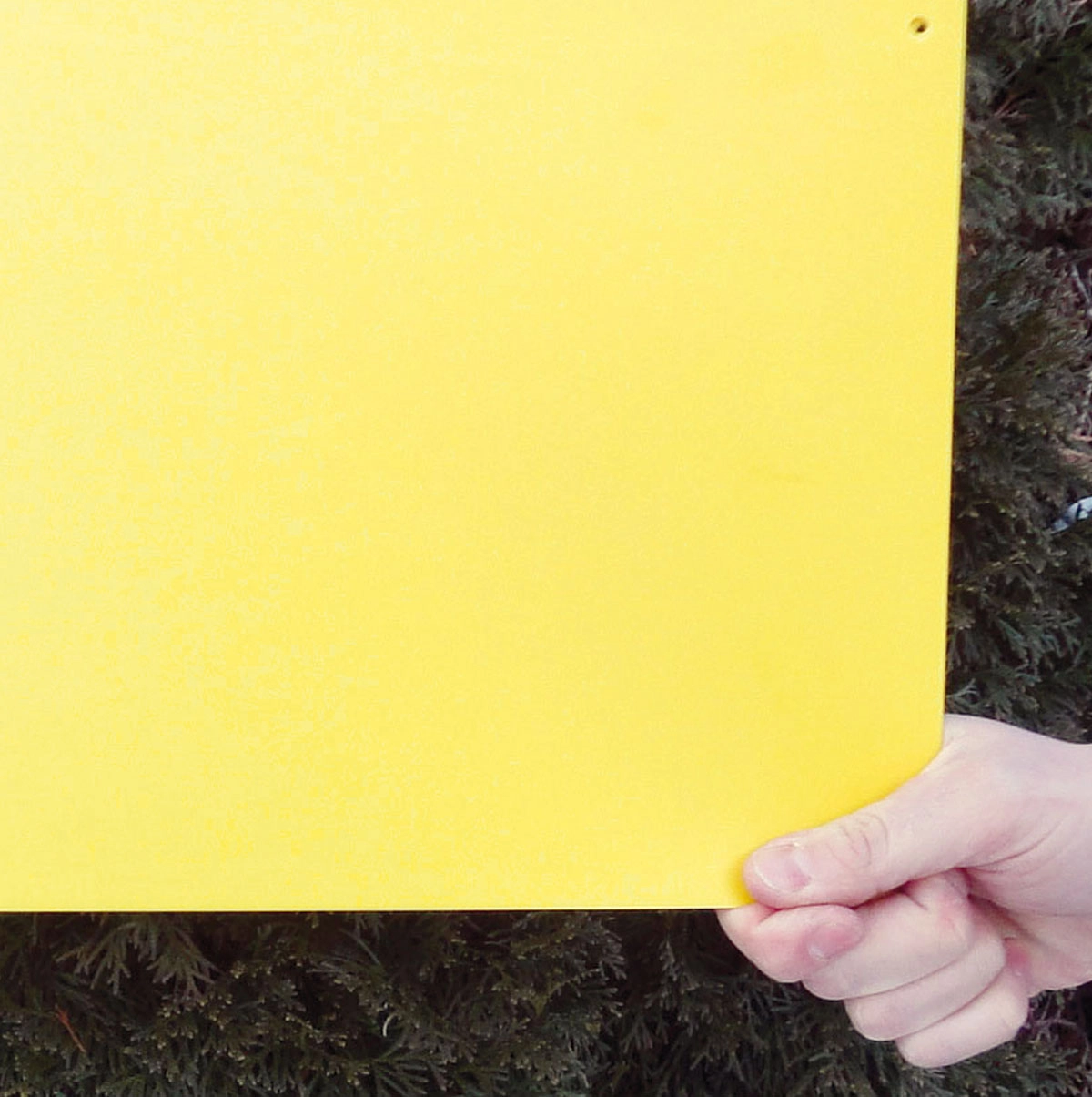
Average rating of 0 out of 5 stars
Colour panel (glue panel) to catch whiteflies shipping unit: pack of 6 pieces panel dimensions: 20 x 25 cm (4 coated with glue on both sides, 2 coated with glue on one side) Attracts whiteflies (additional attracting effect on dark-winged fungus gnats, cherry fruit flies, greenflies). Whiteflies are plant lice. They suck sap on the underside of leaves, especially of ornamental plants and vegetable plants, in particular in greenhouses, flats and winter gardens. Colour panels – Certain colours attract certain pest insects: The attracting effect of certain colours attract pest insects to the trap panels (both sides of the panels are coloured) – No pheromone required. Pest insects stick to the panels that are coated with glue. When panels are fully covered with insects, clean them with a spatula and newly coat them with Soveurode Special Glue, or simply replace panels. Colour panels are trapping and control systems that do not require the use of toxic substances.
Content: 6 Piece(s) (€1.47 / 1 Piece(s))
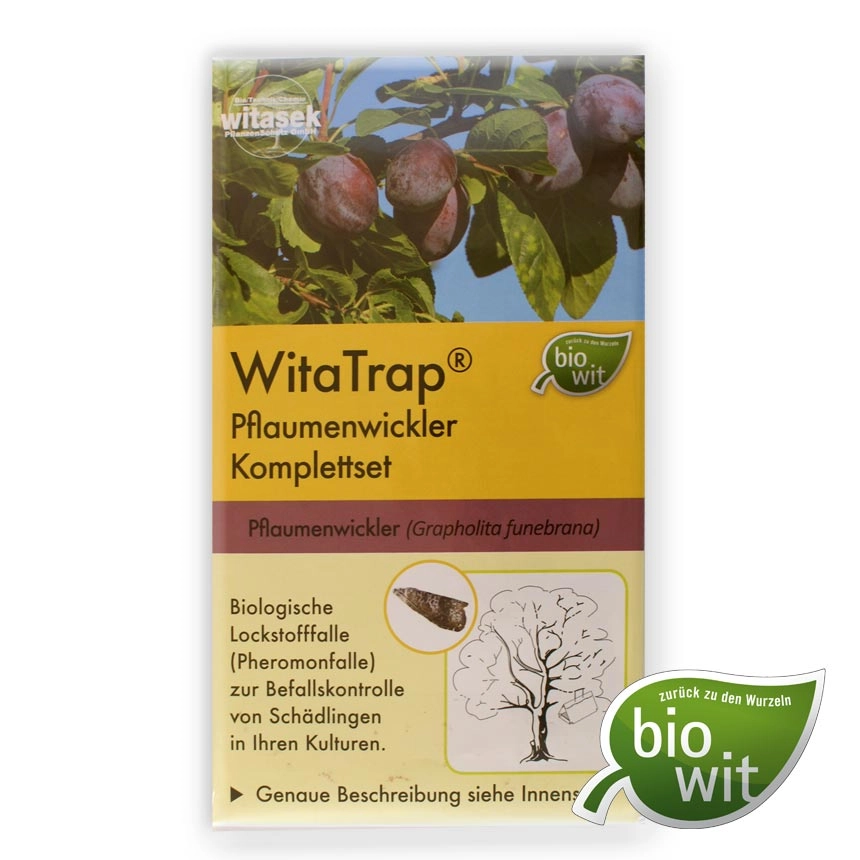
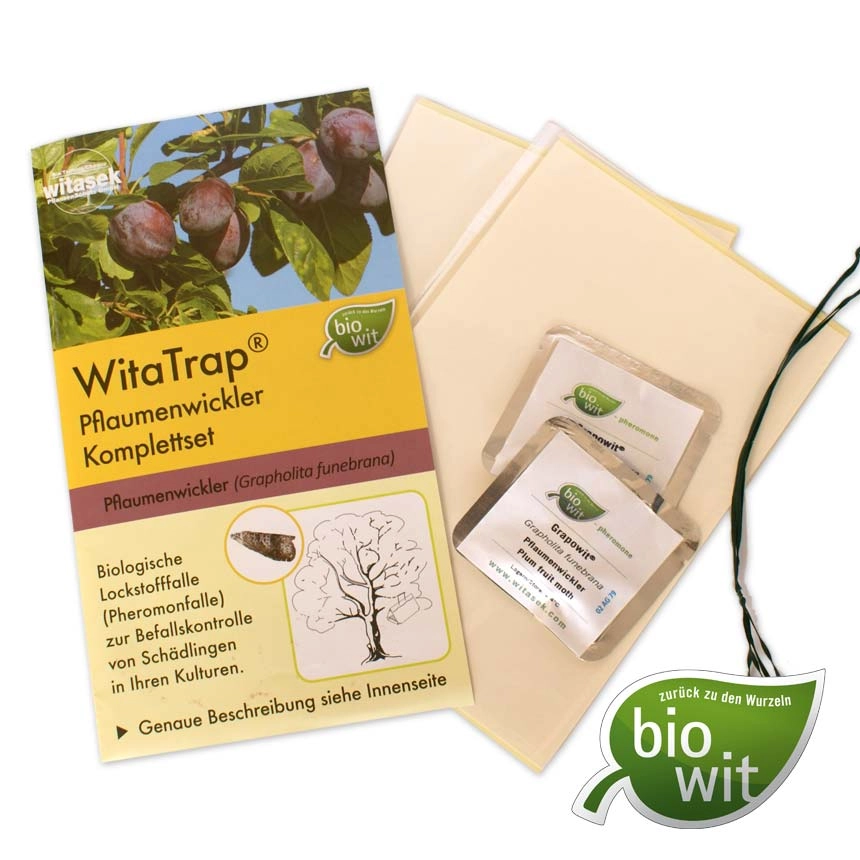
Average rating of 0 out of 5 stars
WitaTrap® Complete Plum Fruit Moth Trap Set Biological attractant trap (pheromone trap) for the management of pest infestation of your cultivars.One trap set consisting of: - 1 trap body (WitaTrap® Delta Super Trap),- 2 adhesive bases (separately packaged!),- 2 pheromone capsules (separately packaged!),- 1 suspension wire for mounting- detailed instructions for use Biology: Pest: plum fruit mothScientific name: Grapholita funebranaInfests: Plums, damsons and mirabelles Main symptoms of infestation: Larvae bore into fruits There is frequently a drop of gum-like substance at the entrance to bore holes The fruit flesh around the stone is destroye Fruits ripen prematurely and drop from trees Main flight periods of the first generation adults: May and June (usually in the evening)Main flight periods of the second generation adults: July to August (usually in the evening) Use:Assemble traps and suspend them from a branch on the upper third of tree crowns.Experience shows that the ripening process begins first on the south side of trees, in the upper third of the crown. It is thus advisable to attach the traps to the external, sunny side of trees before the adults take flight. The number of traps required depends on the size of each tree (2 - 10 traps may be needed). Make sure the external adhesive surfaces are kept free of contact with branches and leaves. Each trap should be checked at regular intervals of 2 - 3 days. Each time a trap is checked, the insects sticking to the adhesive surfaces should be removed using a suitable tool (e.g. twig or wooden scraper) to ensure that the full glue surface is revealed. If surfaces become very soiled, replace the trap or spray with a liquid glue, such as Soveurode special glue.Replace the attractant (pheromone) and whole traps if necessary every 4 - 6 weeks. *Traps should be put in place before the flight phase of the adults. For more information on the insect pest and application, see the enclosed product description.
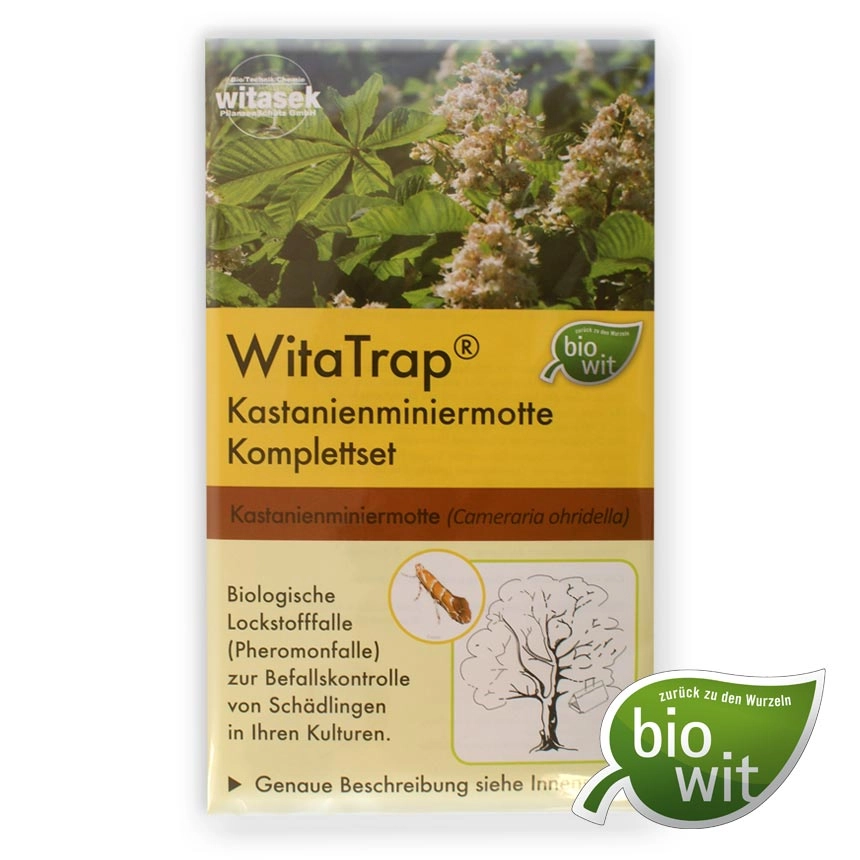
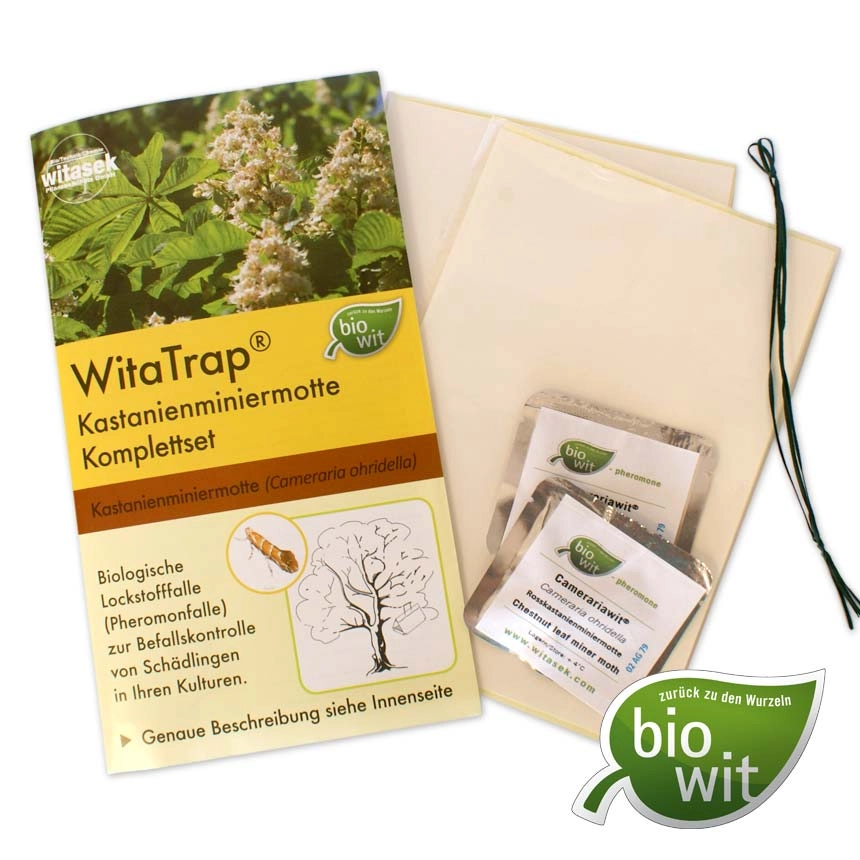
Average rating of 0 out of 5 stars
WitaTrap® Complete Horse Chestnut Leaf Miner Moth Trap Set Biological attractant trap (pheromone trap) for the management of pest infestation of your cultivars.One trap set consisting of:- 1 trap body (WitaTrap® Delta Super Trap),- 2 adhesive bases (separately packaged!),- 2 pheromone capsules (separately packaged!),- 1 suspension wire for mounting- detailed instructions for use. Biology of the pest:Pest: horse chestnut leaf miner mothScientific name: Cameraria ohridellaInfests: chestnut trees, mainly the leaves of the white-flowering horse chestnut Main symptoms of infestation: When the buds emerge in mid-May, the first light brown spots appear on leaves. These spots rapidly become enlarged Main flight periods of generations: late April to August (theoretically, this can continue to October) Use:Assemble the trap and hang it using the suspension wire provided from a branch or post positioned near the tree. (See other side for assembly instructions) Depending on size, it is advisable to use 1 - 3 traps per tree (as a rule of thumb, use one trap for each 30 cm trunk circumference)Hang traps at eye level between the main wind direction and the tree. Make sure the trap entrances are not blocked by twigs and leaves. Each trap should be checked at regular intervals of 2 - 3 days. Each time a trap is checked, the insects sticking to the adhesive base should be removed using a suitable tool (e.g. twig or wooden scraper) to ensure that the full glue surface is revealed. If the base becomes very soiled, replace it or spray with a liquid glue, such as Soveurode special glue.Replace the attractant capsule and the adhesive base if necessary roughly every 4 - 6 weeks. *Traps should be put in place before the flight phase of the adults. For more information on the insect pest and application, see the enclosed product description.
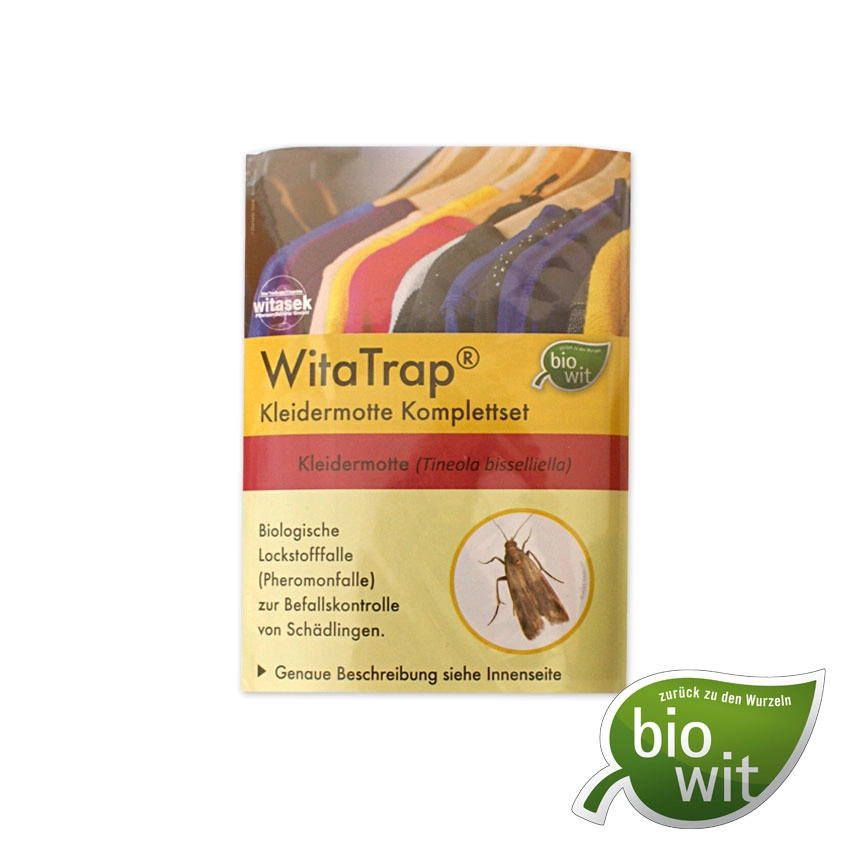
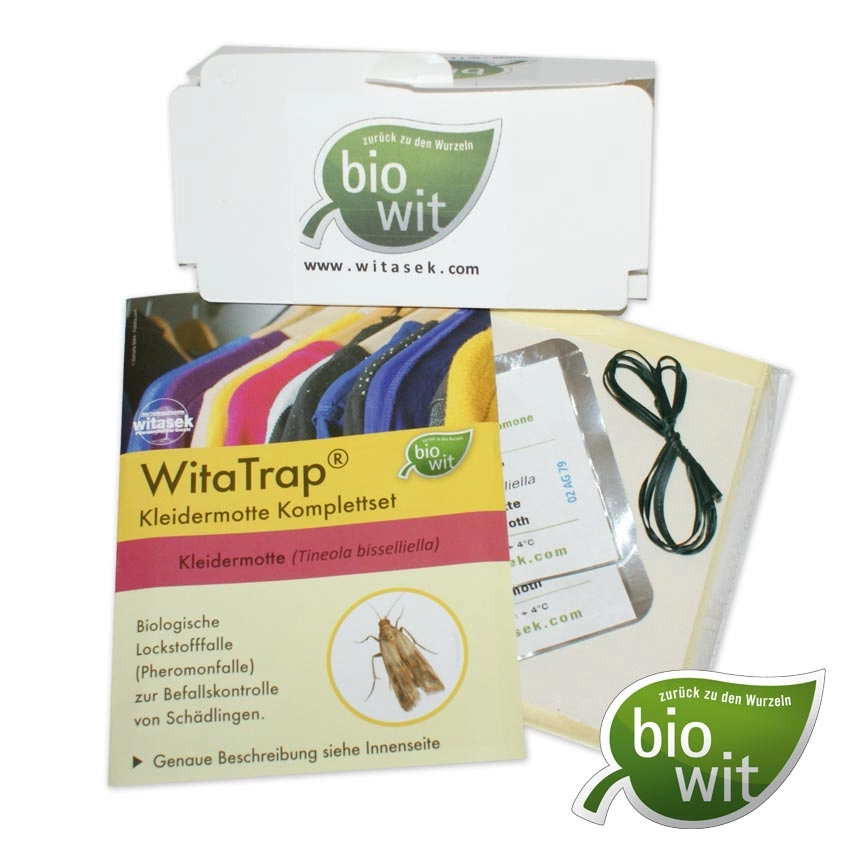
Average rating of 0 out of 5 stars
Natürlicher Pflanzenschutz für Haus & Garten Pheromonfallen eignen sich hervorragend um Schadschmetterlinge in Ihrem Haus zu vermindern.Inhalt: 1 Fallenset besteht aus:- 2 Fallenkörper (WitaTrap® Delta Super Falle klein),- 2 Leimböden (Separat verpackt!),- 2 Pheromonstoppel (Separat verpackt!),- 1 Aufhängedraht zur Montage und- eine genaue Beschreibung. Biologie des SchädlingsSchädling: KleidermotteLateinischer Name: Tineola bisselliellaVorkommen: Kleidung, Schränke und KästenHauptsymptome: Löcher in Textilien Flugzeit der ersten Generation: Mai bis September Anwendung:Die Falle zusammenbauen und im Kleiderschrank bzw. in Räumen erhöht befestigen. Positionieren Sie die Falle hängend oder stehend in Räumen oder Schränken in denen Naturtextilien aufbewahrt werden. Die Falle reicht für einen Raum von bis zu 30 m².Jede Falle sollte in regelmäßigen Abständen von 2-3 Tagen kontrolliert werden. Bei starkem Mottenfang den Leimboden bzw. die Falle erneuen.Der Lockstoff bleibt ca. 4-6 Wochen aktiv und sollte danach ausgetauscht werden. Die Fallen sind vor dem Beginn des Falterfluges aufzuhängen.Die Fallen sind vor dem Beginn des Falterfluges aufzuhängen.Weitere Informationen zum Schadinsekt und zur Anwendung finden Sie in der beiliegenden Produktbeschreibung.
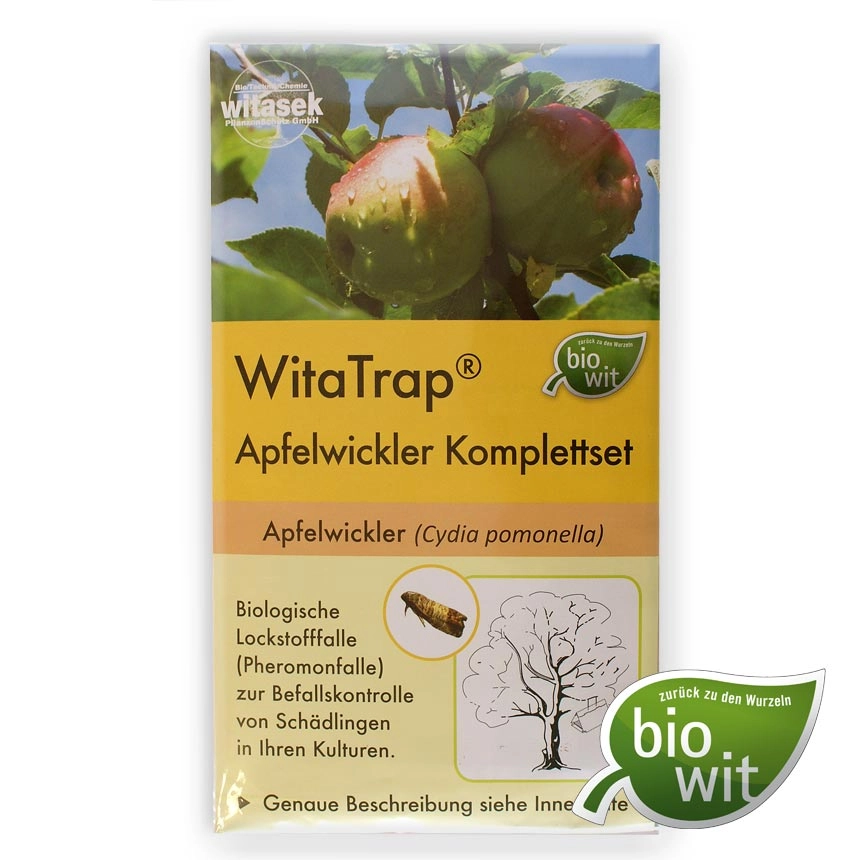
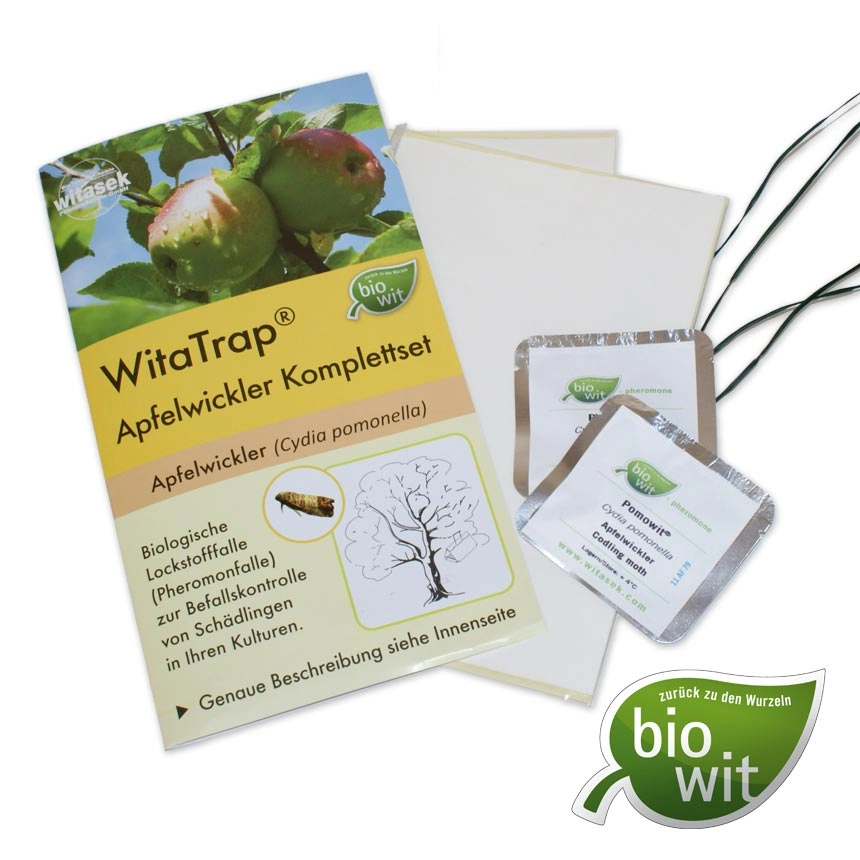
Average rating of 0 out of 5 stars
WitaTrap® Complete Codling Moth Trap Set Biological attractant trap (pheromone trap) for the management of pest infestation of your cultivars.One trap set consisting of: - 1 trap body (WitaTrap® Delta Super Trap),- 2 adhesive bases (separately packaged!),- 2 pheromone capsules (separately packaged!),- 1 suspension wire for mounting- detailed instructions for use Biology of the pest Pest: codling mothScientific name: Cydia pomonellaInfests: apples (pears) Main symptoms of infestation: The larvae of the codling moth damage fruits by boring into them. Faecal particles will be visible at the opening of bore holes. Fruits drop from trees prematurely. Main flight periods of the first generation adults: May and June/JulyMain flight periods of the second generation adults: If climatic conditions are suitable a second generation can develop in the same year. The adults then take flight in July/August. Use:Assemble the trap and hang it using the suspension wire from a branch or post. In order to avoid attracting the pest insects directly to the apple or pear tree to be protected, hang the trap from another tree (that is not a fruit tree) in the vicinity. If this is not possible, the trap can also be hung from a suitably high post driven into the ground.Hang the trap at eye level between the main wind direction and the tree. Make sure the trap entrances are not blocked by twigs and leaves. Each trap should be checked at regular intervals of 2 - 3 days. Each time a trap is checked, the insects sticking to the adhesive base should be removed using a suitable tool (e.g. twig or wooden scraper) to ensure that the full glue surface is revealed. If the base becomes very soiled, replace it or spray with a liquid glue, such as Soveurode special glue. Replace the attractant capsule and the adhesive base if necessary roughly every 4 - 6 weeks. Traps should be put in place before the flight phase of the adults. For more information on the insect pest and application, see the enclosed product description.
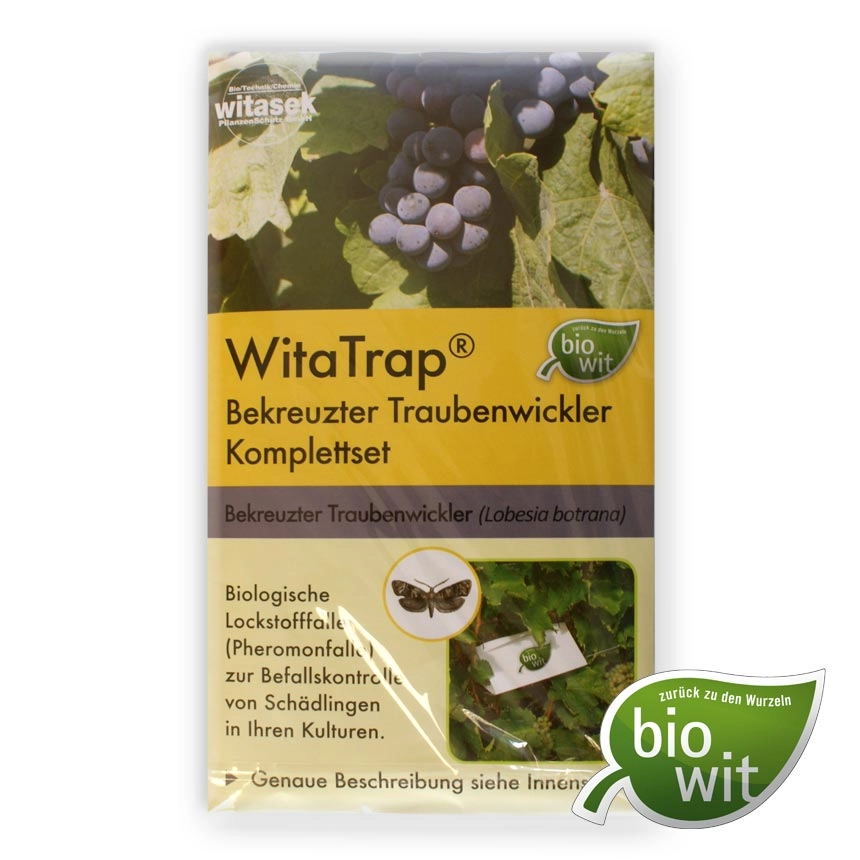
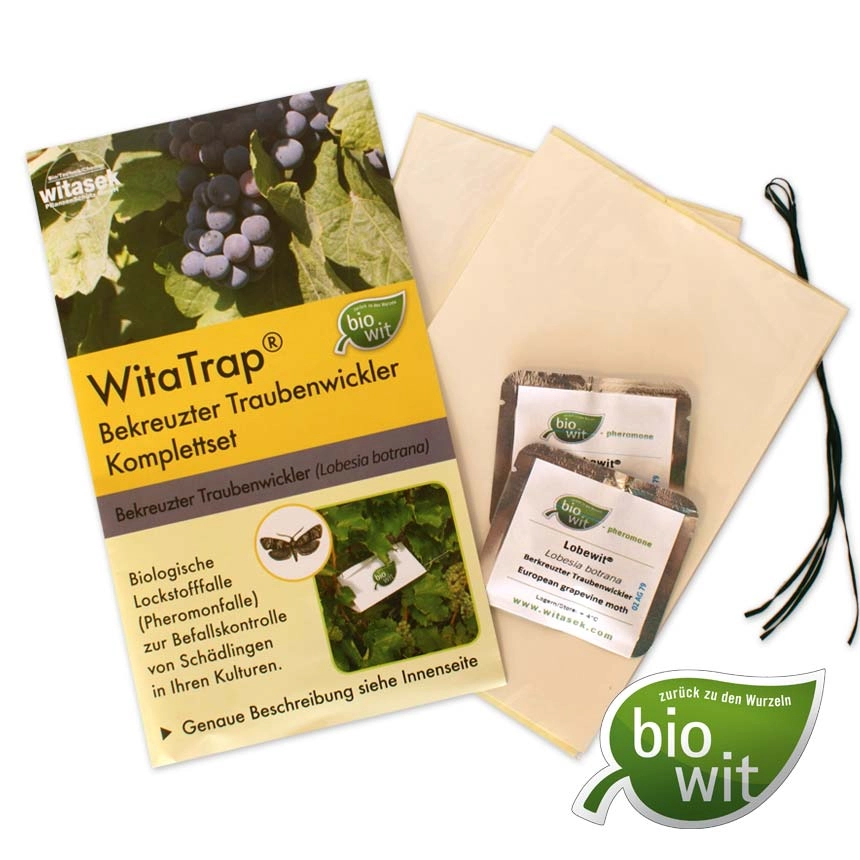
Average rating of 0 out of 5 stars
WitaTrap® Complete European Grapevine Moth Trap Set Biological attractant trap (pheromone trap) for the management of pest infestation of your cultivars.One trap set consisting of: - 1 trap body (WitaTrap® Delta Super Trap),- 2 adhesive bases (separately packaged!),- 2 pheromone capsules (separately packaged!),- 1 suspension wire for mounting- detailed instructions for use Biology of the pestPest: European grapevine mothScientific name: Lobesia botranaInfests: grapevines, but is polyphagous and can infest other host plants Main symptoms of infestation: Flowers and fruits spun together by the webs of larvae Feeding damage to fruits and webs on fallen grapes Sour rot can develop during wet weather Main flight periods of the first generation adults: April/early MayMain flight periods of the second generation adults: June/JulyMain flight periods of the second generation adults: from August Use:Assemble traps and hang them in the infested vineyard.They can be hung directly from trellis wires. If this is not possible, the trap can also be hung from a suitably high post driven into the ground.Make sure the trap entrances are not blocked by tendrils and leaves. Each trap should be checked at regular intervals of 2 - 3 days. Each time a trap is checked, the insects sticking to the adhesive base should be removed using a suitable tool (e.g. twig or wooden scraper) to ensure that the full glue surface is revealed. If the base becomes very soiled, replace it or spray with a liquid glue, such as Soveurode special glue. Replace the attractant capsule and the adhesive base if necessary roughly every 4 - 6 weeks. Traps should be put in place before the flight phase of the adults. For more information on the insect pest and application, see the enclosed product description.
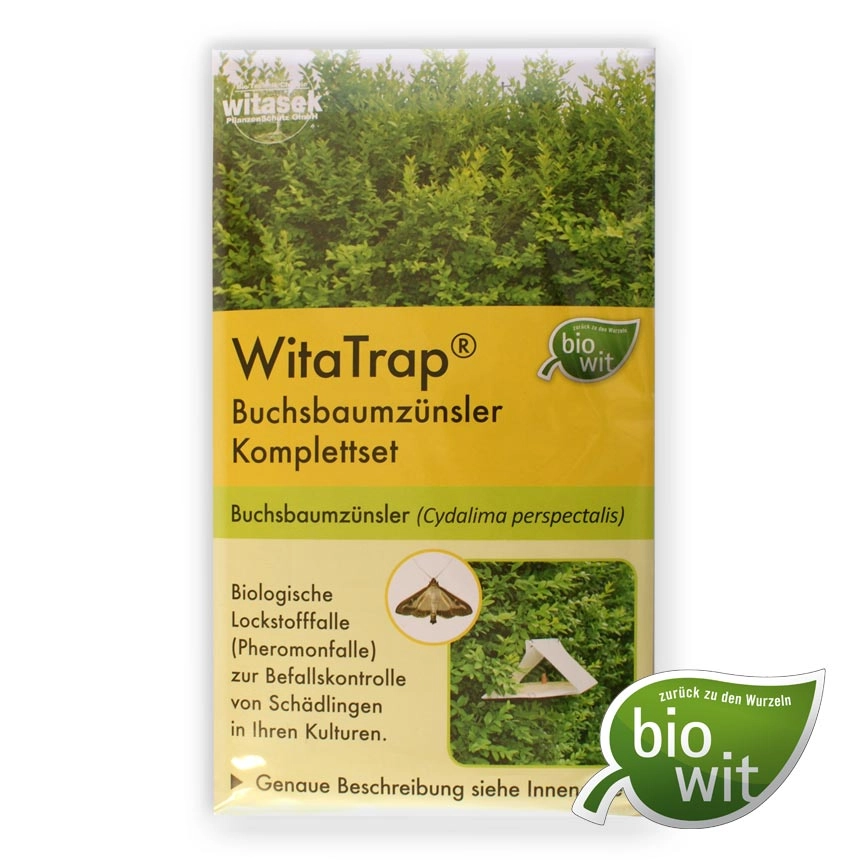
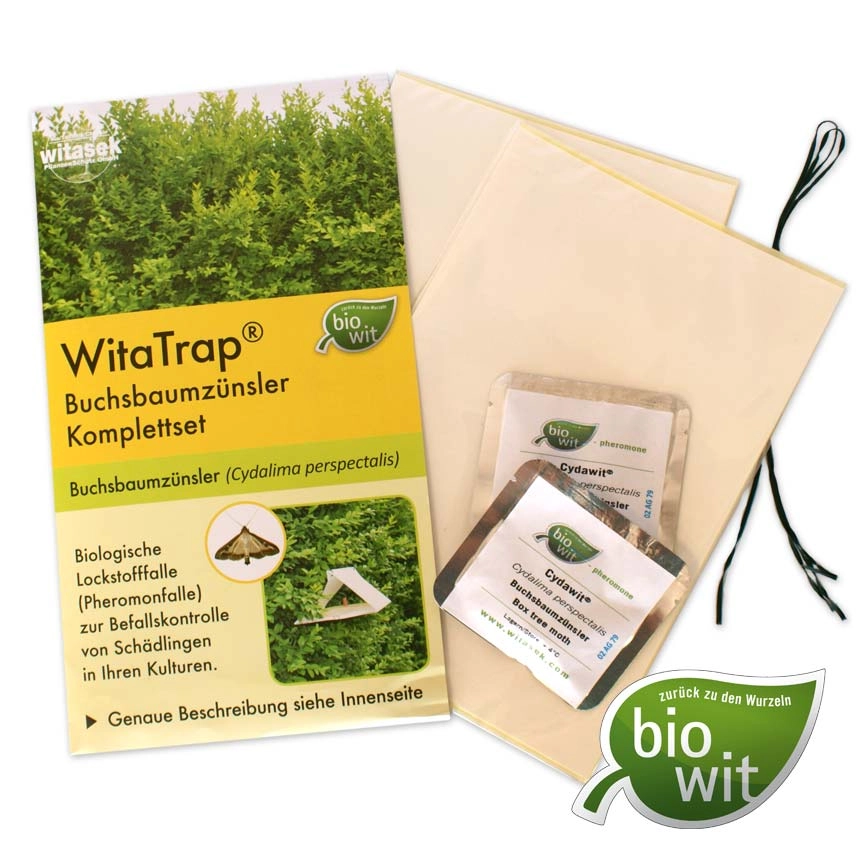
Average rating of 0 out of 5 stars
WitaTrap® Complete Box Tree Moth Trap Set Biological attractant trap (pheromone trap) for the management of pest infestation of your cultivars. One trap set consisting of: - 1 trap body (WitaTrap® Delta Super Trap),- 2 adhesive bases (separately packaged!),- 2 pheromone capsules (separately packaged!),- 1 suspension wire for mounting- detailed instructions for use Biology of the pestPest: Box tree mothScientific name: Cydalima perspectalisInfests: various species of box treeMain symptoms of infestation: Signs of damage to and light beige discolouration of leaves Bright green faecal particles caught in webs and under trees Webs become clearly visible if there is severe infestation First appearance of caterpillars: mid-March/early April --> use insecticide if necessaryFirst generation flight periods: early June --> set traps*Second appearance of caterpillars: mid- to late July --> use insecticide if necessarySecond generation flight periods: August/September --> set traps*Third appearance of caterpillars: September/October --> use insecticide if necessary *PLEASE NOTE: Traps must be put in place before the moths take flight. The traps capture only the male moths. Use:Assemble the trap and hang it using the suspension wire from a branch or post. In order to avoid attracting the pest insects directly to the box tree to be protected, hang the trap from another tree (that is not a box tree) in the vicinity. If this is not possible, the trap can also be hung from a suitably high post driven into theground.Hang the trap at eye level to ground level, depending on height of the tree, between the main wind direction and the tree. Make sure the trap entrances are not blocked by twigs and leaves. Each trap should be checked at regular intervals of 2 - 3 days.Each time a trap is checked, the insects sticking to the adhesive base should be removed using a suitable tool (e.g. twig or wooden scraper) to ensure that the full glue surface is revealed. If the base becomes very soiled, replace it or spray with a liquid glue, such as Soveurode special glue. Replace the attractant capsule and the adhesive base if necessary roughly every 4 - 6 weeks. For more information on the insect pest and application, see the enclosed product description.

